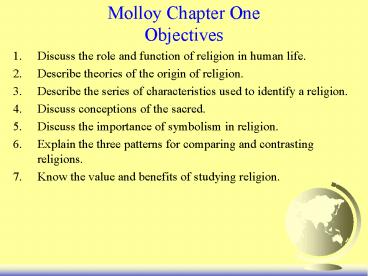Molloy Chapter One Objectives - PowerPoint PPT Presentation
1 / 13
Title:
Molloy Chapter One Objectives
Description:
Describe theories of the origin of religion. Describe the series of characteristics used to identify a religion. ... Discuss the importance of symbolism in religion. ... – PowerPoint PPT presentation
Number of Views:225
Avg rating:3.0/5.0
Title: Molloy Chapter One Objectives
1
Molloy Chapter OneObjectives
- Discuss the role and function of religion in
human life. - Describe theories of the origin of religion.
- Describe the series of characteristics used to
identify a religion. - Discuss conceptions of the sacred.
- Discuss the importance of symbolism in religion.
- Explain the three patterns for comparing and
contrasting religions. - Know the value and benefits of studying religion.
2
1-1 The Role and Function of Religion
- Where do we come from? Where are we going?
- What/Who are we?
- Why are we here? What do we do while were here?
- Mortality
- Meaning
- Morality
3
1-2 The Role and Function of Religion
- We are not just storytellers we are
Storydwellers - We live in our stories. We see and
understand our world through them - Four main types of sacred story
- Myths of Nature - oral religions (ch. 2) and
some new religions (ch. 12) - Myths of Harmony - Chinese Taoism and
Confucianism (ch. 6) - Myths of Liberation Hinduism (3), Buddhism
(4), and Jainism (5) - Myths of History Judaism (8), Christianity (9),
and Islam (10)
4
1-3 Key Theorists of Religion
- Tylor FrazierBelief in Spirits. Human appease
or channel power of Spirits (Animism) - JamesBrings Meaning and Vitality (healthy)
- FreudProjection of Childhood Experience
(pathology) - JungIndividuation Personal Development
archtypes symbols - OttoSense of the Holy mysterium tremendum et
fascinans
5
1-4Key Terms
- AnimismNature filled with Spirits
- PolytheismMany Gods
- MonotheismOne God
- PantheismAll is God
- AtheismNo God or Gods (today used most often for
the denial/rejection of God) - NontheismA system that does not include or
need" a God (tradl. Buddhism) - AgnosticismCannot Know Existence of God
- TranscendentSacred is Beyond this World
- ImmanentSacred is Within this World
6
1-5 Development?
- Schmidtoriginal monotheism lesser or other gods
and spirits later (a Biblical view?) - Monotheism superseded Polytheism
- Evolution from Animism to Polytheism to
Monotheism (a Christian bias?) - Grand developmental theories risk bias and
oversimplification - Religious Studies today is more comparative
considering merits of all
7
1-6 What makes Religion Religion?
- Re-ligo - to tie together, reconnect (think of
ligament) - Classically Religio respect or awe for the
sacred proper observance of ceremony (cult
care for the deities) conscientiousness - By extension, then, religion tying ones life
together (hub of a wheel not a spoke)
8
1-7 Can we list essential elements or
characteristics?
- Belief system provides a worldview an ordered
way of constructing reality - Community a social reality promotes
cohesiveness, sense of belonging - Central myths foundational stories
- Ritual beliefs and central stories are acted
out (performed) - Ethics a code of behavior oriented toward,
often generated by the sacred - Emotional experiences awe, dread, guilt,
conversion, purification/liberation, devotion,
ecstasy, peace - Material expression art, music, sounds (bells),
smells (incense), masks clothing - Sacred persons, places, things
9
1-8 Symbolic Language
- Religious expression is symbolic
- Words, actions, physical objects tangible human
experiences - are employed to express what is ultimately
inexpressible
10
1-9 Patterns among Religions1. Orientations
- (Patterns are not conceptual straitjackets)
- SacramentalEmphasizes Ritual
- External experiences literally symbolize sacred
reality - PropheticEmphasizes Belief and Morality
- More interior, cerebral
- MysticalEmphasizes Sense of Oneness with God or
the Universe - Focus on loss of self in the sacred immediate
experience - Note that these are not mutually exclusive but
represent emphases
11
1-10 Patterns among Religions 2. Varied
Attitudes or Worldview Among Religions
- Sacred RealityTranscendent or Immanent Personal
or Impersonal - UniverseCreated or Eternal
- NaturePerfect or Imperfect (cf. dualism)
- TimeCyclical or Linear
- Human BeingsIndividual Important or Part of
Nature and Society - Words and ScripturesValuable or Inadequate
- Exclusiveness vs. Inclusiveness
12
1-11 Patterns Among Religions3. Male and Female
- Ancient importance of the feminine
- Rise of male dominance (nevertheless, feminine
hasnt disappeared see box on p. 15) - Renewed emphasis on female equality and new roles
for women in society influence new consideration
of nature of sacred and revival of ancient
religious sensibilities
13
1-12 A Multitude of Methods
- Many angles from which to study religion
- Ours is a phenomenological method - observation
of how humans are religious - This is a comparative method of religion
- Seek to understand sympathetically
- Find patterns that reveal commonality
- Differentiate among religions to reveal
uniqueness - A warning 1) The researcher must be aware of
her/his own presuppositions and biases. It is
easy to impose categories on the other. 2) Can
we ever really speak of the typical ?































